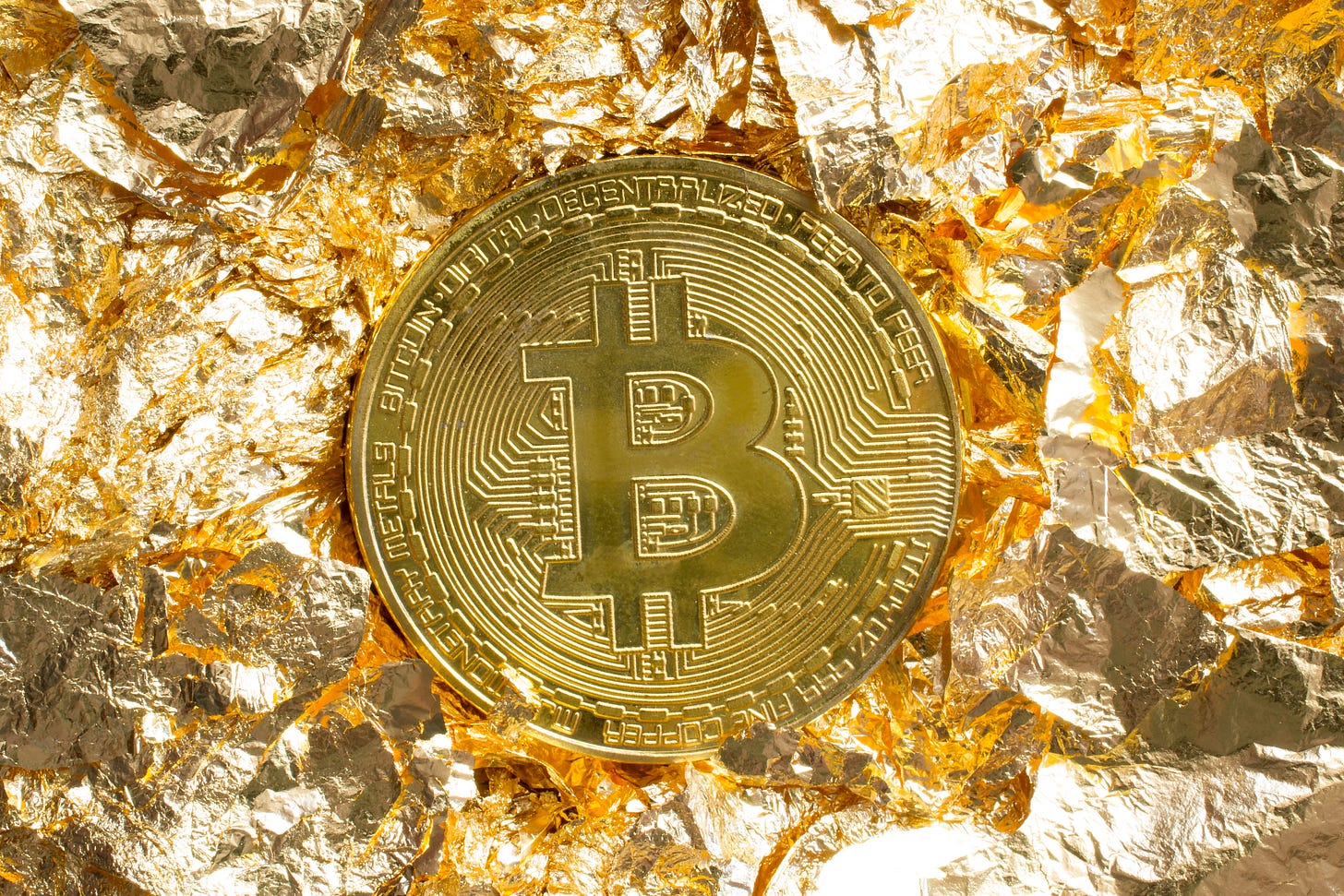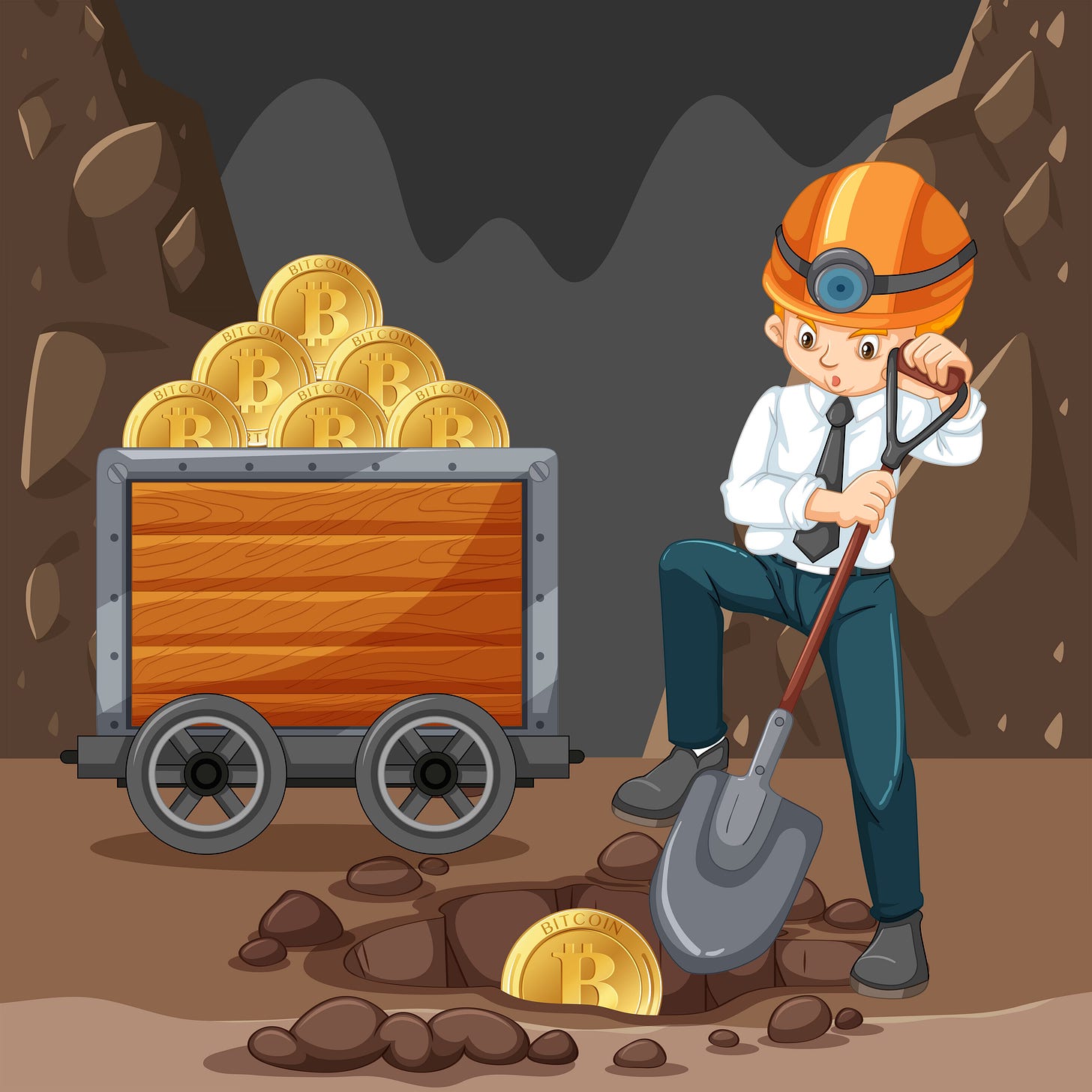Bitcoin 201: Why It Compares to Gold & What Happens in 2140
The Year Where it All Ends
This is MathMadeSimple, by Álvaro Muñiz: a newsletter where you will discover how math appears in every aspect of your life, from decision-making to personal finance.
Having a bitcoin means something like having digital gold.
There are now a bit less than 20M bitcoins in circulation, and each day this number increases by about 500. The more bitcoins there are in circulation, the fewer bitcoins are created each day. The total number of bitcoins in circulation will never be more than 21M.
Having a bitcoin means having something very limited.
Today in a nutshell
To own a bitcoin you can either mine it or buy it.
Mining a bitcoin means ‘creating’ a new bitcoin.
The ‘halving’ protocol of Bitcoin ensures that there will never be more than 21M bitcoins.
This makes Bitcoin similar to gold: it is scarce and hard to extract.
Bitcoin 101—Revisited
Our first post about Bitcoin explained what Bitcoin actually is:
Bitcoin is a digital document containing the list of all the transactions that were made since 2009.
To avoid having a central authority that holds the list, everyone participating in Bitcoin owns a copy of the list.
The key idea of Bitcoin is to require proof of work to trust a transaction. This requires solving a mathematical puzzle, and people who work on solving puzzles are called miners.
But what does it mean to have a bitcoin?1 Where do you buy one? How many bitcoins are there? Who creates them, and how?
This is what we will talk about today.
Buying a bitcoin (external)
The first thing you can do to own a bitcoin is buying it.
Just as with any other good or service, you can exchange bitcoin for cash. You find someone who has a bitcoin and offer them a deal: ‘I’ll give you $76,000 if you give me a bitcoin’. If they agree, they add a transaction to the ledger looking something like this:
I, User X, transfer User Y 1 bitcoin
Signed: User X
In exchange, you will get your $76,000 and give it to User X (either in cash, bank transfer…we are now outside the Bitcoin world).
Now you are in the system. There is a transaction in the ledger that says that you own 1 bitcoin: it’s yours.
Going to a cafe where the owner accepts Bitcoin as payment? You get your coffee and add a transaction to the ledger:2
I, User Y, transfer User Z 0.000051 bitcoin.
Signed: User Y
Feeling like you need some real $$ to go through life? Just as you can exchange dollars for euros, you can go to a crypto exchange and swap your bitcoin for dollars. You entered the system by exchanging your dollars for bitcoin: someone wanted dollars and you wanted bitcoin. Now you exchange your bitcoin for dollars: you want dollars and someone else instead wants bitcoin.
In this sense, bitcoin is just like another currency.
And just like any other currency, the exchange rate between bitcoin and dollars depends on offer and demand.
Creating a bitcoin (internal)
There is another way to get a bitcoin: you can create a bitcoin.
This is not as wild as it might sound. The Federal Reserve is printing about $100,000M in 2025. The European Central Bank is not falling short: 70,000M€. Governments print money all the time, and Bitcoin does too.
But there is a crucial difference.
When and how many dollars or euros are printed is a decision of the Fed and the ECB.
When and how many bitcoins are created is fixed since the birth of Bitcoin.
This is a completely different monetary policy. It was fixed once and for all in Bitcoin’s source code and no one can alter it. It is built deep into Bitcoin’s infrastructure.
Who gets a newly created bitcoin is also fixed by Bitcoin’s protocol:
Each time a miner solves a mathematical puzzle to add a transaction to the ledger, they are rewarded with some number of bitcoins. These are newly-created bitcoins: they have just been ‘mined’.
This is an incentive for miners to work on mathematical puzzles and keep the network running. If they work hard on solving puzzles, they get bitcoins as a reward.
Bitcoin rewards miners in its own currency.
Halving
Let me recap what we just learned:
You can get bitcoins that are already in circulation by exchanging them for cash.
You can get new bitcoins by solving mathematical puzzles: you do the work and get payed in bitcoins in return.
Say people get obsessed with Bitcoin. Everyone wants bitcoins, so everyone starts mining like crazy.
Before only a few people had bitcoins: it was scarce and valuable. Now everyone has bitcoins: it is abundant and cheap. The Bitcoin economy is suffering from inflation.
Except that will never happen in Bitcoin.
Bitcoin addresses the issue of inflation with a protocol called halving.
Halving in the automated process by which, every four years, the number of bitcoins given as a reward to miners is cut in half.
When Bitcoin first started in 2009, each miner was given 50 BTC for each puzzle they solved. At today’s price, that’s just over $3.5M for solving a mathematical puzzle. Before you start thinking what the hell you were doing in 2009, keep in mind that back then Bitcoin was worth less than $0.10. The information you had then is not the information you have now.
The latest halving happened in April 19, 2024, and since then miners get ‘only’ 3.125 BTC for each puzzle they solve. By ‘only’ I mean $240,000 at today’s price. But again, before you quit your job and start mining bitcoin, you should consider how f*cking expensive it is to mine a bitcoin.
In 2028 the reward will halve and miners will receive only 1.5625 BTC as a reward.
In 2032 it will halve again to only 0.78125 BTC.
And sometime around 2140, no more bitcoins will be issued.3
By 2140, there will be around 21M bitcoins in circulation—and there will never be more.
This is the reason people compare Bitcoin to gold.
There is a fixed amount of gold in our planet. Much of it is mined already, and whatever is left is harder and harder to mine. In any case, there is a limited amount. At some point, when all gold is mined, there will be a clear distinction: those who have gold and those who haven’t. If you don’t and you want to have some, the only way to get it would be for someone who already has it to sell it to you.
The same thing happens with Bitcoin. By 2140, whoever has bitcoins is in and whoever doesn’t is out. If you want to get in after that, you’ll need to find someone that already has it and that is willing to sell it to you.
It will be scarce. Which means that, if it is also sought-after, it can be very valuable.
Who will be the lucky miner to
What’s coming:
Once all bitcoins are in circulation and there are no rewards, will miners stop solving puzzles?
If everyone owns a copy of the ledger and can see all transactions…what happens with privacy?
How are transactions added to the ledger? The Blockchain
Can’t wait to learn more?
Why exactly 21M bitcoin? This video gives an interesting idea.
Ask questions in the comments! Let me know what you’d like to know more about, or what was not clear from this post.
There is a distinction between Bitcoin and bitcoin. Bitcoin (with capital B) refers to the system (the ledger, the ‘banking system’), while bitcoin (with small b) is a unit of the currency.
No, it’s not a typo, a $3 coffee will only cost you 0.000051 bitcoins.
Since I am a mathematician I have to tell you why this is. It involves infinite sums: you can show that, if you divide by 2 infinitely many times and add the results together, you get
1 + 1/2 + 1/4 + 1/8 + … = 2
Summing and infinite number of things can give you something finite. This is the key to why decreasing the reward by half every four years will result in a finite number of bitcoins.




Such an interesting post! Loved it. Can't wait for the next ones!!